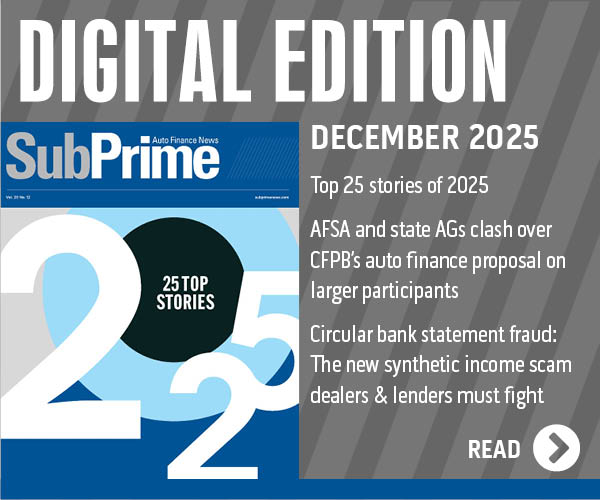TransUnion: 4Q National Auto Loan Delinquency Rate Flat
By subscribing, you agree to receive communications from Auto Remarketing and our partners in accordance with our Privacy Policy. We may share your information with select partners and sponsors who may contact you about their products and services. You may unsubscribe at any time.
CHICAGO — In a positive turn for auto lenders, TransUnion's quarterly analysis determined that the latest reading on the national 60-day auto delinquency rate — which is the ratio of loan borrowers 60 or more days past due — showed no change between the third and fourth quarters of 2009.
Analysts then revealed this week the rate stood at at 0.81 percent.
TransUnion also indicated the year-over-year delinquency rate at the national level decreased by 5.81 percent in the fourth quarter.
Delving deeper, analysts learned on a state-level basis that 18 states experienced a drop in their quarter-to-quarter delinquency rates. Moreover, 35 states showed a drop on a year-over-year basis.
TransUnion pointed out that auto loan delinquency was highest in Mississippi and Alabama at 1.45 percent and 1.39 percent, respectively. Meanwhile, the firm determined the lowest auto loan delinquency rates were found in Alaska at 0.29 percent, North Dakota at 0.32 percent and South Dakota at 0.41 percent.
Furthermore, TransUnion mentioned the largest improvements in delinquency from the previous quarter were found in Alaska — a 35.6-percent decrease from 0.45 percent — and Idaho — a 28-percent decrease from 0.67 percent.
Subscribe to Auto Remarketing to stay informed and stay ahead.
By subscribing, you agree to receive communications from Auto Remarketing and our partners in accordance with our Privacy Policy. We may share your information with select partners and sponsors who may contact you about their products and services. You may unsubscribe at any time.
Company analysts also shared that the average auto debt nationally increased slightly between the third and fourth quarters of 2009. They indicated it crept up from $12,542 to $12,568.
On a year-over-year basis, however, analysts said auto debt fell by 1.1 percent.
The state with the largest debt burden was Nevada at $14,376, followed by Texas at $14,372, according to TransUnion. On the other side of the spectrum, the firm noticed that the lowest average debt was in Nebraska at $10,738.
Finally, analysts found the states with the steepest annual increases in average auto debt as a percentage were Michigan, (3.47 percent), Tennessee (1.6 percent) and Montana (1.56 percent).
They said New Mexico experienced the sharpest drop in average auto debt (3.0 percent) followed by Nevada (2.3 percent).
"Going against traditional seasonal patterns, the flattening of auto delinquency rates in the fourth quarter may be an optimistic sign for payment behavior over the remainder of this year," explained Peter Turek, automotive vice president in TransUnion's financial services business unit.
"Since 2000, auto delinquency rates have increased in the fourth quarter except for one occasion back in 2003," Turek continued. "In fact, at the start of the recession (fourth quarter of 2007), the auto delinquency rate increased nearly 15 percent from the prior quarter.
"Part of the reason why we may be seeing a gradual turnaround in delinquency rates is the impact of new lower risk loans over the past several quarters including new loans from the popular government program, Cash for Clunkers," Turek added.
Looking forward, TransUnion modified its national 60-day auto delinquency rate forecast downward over the course of the current year. Now the firm projects delinquencies to be in the range of 0.75 and 0.80 percent by year's end.
"Given a more positive outlook for GDP and other economic indicators except for employment, our current forecasting models point to a national 60-day auto delinquency rate of 0.65 percent by midyear, a decrease of 19.7 percent compared to fourth quarter 2009," Turek explained.
"However, the seasonality and forecast of car sales will influence delinquency throughout the rest of this year and into 2011," he pointed out.
TransUnion also discussed other segments of consumer credit, including mortgages and credit cards, in its latest analysis. The firm found:
—Mortgage loan delinquency (the ratio of borrowers 60 or more days past due) increased for the 12th straight quarter, hitting an all-time national average high of 6.89 percent for the fourth quarter of 2009. This quarter marks the first time the mortgage delinquency rate increase did not decelerate after doing so for three consecutive periods. This statistic, which is traditionally seen as a precursor to foreclosure, increased 10.24 percent from the previous quarter's 6.25 percent average. Year-over-year, mortgage borrower delinquency is up approximately 50 percent (from 4.58 percent).
—The average national mortgage debt per borrower increased (0.29 percent) to $193,690 from the previous quarter's $193,121. On a year-over-year basis, the fourth quarter 2009 average represents a 0.47-percent increase over the fourth quarter 2008 average of mortgage debt per borrower level of $192,789. Officials said this further suggests stabilization in housing prices, traditionally seen as a key ingredient for a sustained economic recovery.
—The national credit card delinquency rate (the ratio of bankcard borrowers 90 days or more delinquent on one or more of their credit cards) increased to 1.21 percent in the fourth quarter of 2009, up 10 percent over the previous quarter. Year-over-year, credit card delinquencies remained flat.
—Average credit card borrower debt (defined as the aggregate balance on all bank-issued credit cards for an individual bankcard borrower) drifted downward nationally by 3.18 percent to $5,434 from the previous quarter's $5,612, and down 5.15 percent compared to the fourth quarter of 2008 ($5,729).
TransUnion reiterated that its latest statistics and analysis are part of an ongoing series of quarterly consumer lending sector analysis focusing on credit card, auto loan and mortgage data available on TransUnion's Web site.
The firm stressed that information for this analysis is culled quarterly from approximately 27 million anonymous, randomly sampled, individual credit files, representing approximately 10 percent of credit-active U.S. consumers and providing a real-life perspective on how they are managing their credit health.


